|
In Three Parts...
--------------------------------------------
Page One -- Page Two -- Page Three
--------------------------------------------
"The interesting thing is the product, not the person."
C77: It seems that you have a lot of fans, people who write songs about you, one woman who had sent in an embroidered apron with your image on it? What do you think about the industrial designer as rock star? It's sort of a hot topic right now.
JD: Is it? (Laughter). I always find that slightly worrying. I mean, the interesting thing is the product, not the person. And that's true of architects as well. It's different for rock stars of course, because the personality is part of the singing, which is part of the music--and the same with actors. But I think the product is always the important thing.
C77: But let's go back to someone we talked about before: Buckminster Fuller, who said, "I am not a thing--a noun. I seem to be a verb..." I suppose you can separate the man from his work, but it's almost more fun not to.
JD: If you hear him speak, I mean, that was enormously revealing, because it reinforced what you may have seen subliminally but not quite realized. But when I heard him talk, the thing that surprised me was that you thought of everything he did from the housewife, consumer, or user's point of view. And that's how he explained it. Whereas I think a lot of people who were doing what he was doing might have talked about the engineering or something else. So the house started off as an ecological idea. Why have a 300-ton house, he'd ask? Why not have a one-ton house?
C77: Right. His big design criterion was weight: If it weighed less, it was better. I love that.
JD: Exactly. And also his system for getting the dust out of the house--reducing the pressure difference inside the house from the outside of the house--he had a system for collecting the dust and getting it outside. Bad news for me!
C77: Well if you're going to be foiled by somebody, you can't do better than Buckminister Fuller!
JD: Hearing him talk added tremendously to understanding his work--for consumers, as well as design students, and then for anybody. But I think most of the time, people's work should speak for them.
"If you are home and you're bored, and you start thinking about the problem, there's not much you can do about it, because you can't build a prototype."
C77: I'm wondering if you have any rituals in your life that have informed your design process. Perhaps away from the office; rituals that have made a difference in how you approach design and how you live design?
JD: Well, that's quite a complex question, isn't it? I think one thing I do do is sort of separate work from my private, non-work life, because I think it's quite important to be a very rounded person, and a catholic person. So I tend to stop thinking about design or a particular problem when I leave there. I work quite long hours, and I don't stop for lunch, so I work absolutely intensively. And then I walk away from a problem, try to clear my brain, and recharge my batteries. And I think that's quite important, but it doesn't always work.
But I think in the sort of work I do, you don't have a brain wave away from work anyway, because the development comes from building a prototype and testing, building another prototype and testing again. And then kind of learning from it; learning from the failures. So actually, if you are home and you're bored, and you start thinking about the problem, there's not much you can do about it, because you can't build a prototype. So my discipline is to tend to shut off. But I do start, if I'm doing the dishwashing or something--loading the dishwasher, because it's a fairly tedious chore--and well, you know the rest...I start wondering about this dishwasher, or thinking about various aspects of it...
C77: The curse of the designer!
JD: No, I enjoy it! I do enjoy it. But referring back to an earlier question about how we work--the thing about building prototypes, and all the ideas, and all the creativity--it doesn't occur on a drawing board, or sitting around the table, or having bloody brainstorming sessions...
C77: With Post-It notes!
JD: Right. I mean, it's going in the workshop, building something, and having failures. And most of the inventions have occurred by accident because we were trying to do something, and something else occurred. And when you read about inventions, you think that the genesis stories of these things are apocryphal, and you say, "Oh, that can't quite be true...they didn't discover that by accident...it didn't vulcanize by accident!" But it did, because he was probably trying to do something else.
C77: Polycarbonate is another example. Post-It notes another.
JD: Exactly. So that going to the workshop, and testing things, and recording results, painstakingly, and doing sketches of the test you're doing, and writing the results, and then making some notes. And keeping a very good record of all of that--it's all crucially important.
"We can mix in another dimension to people's lives, a caring dimension."
C77: Talk to us about your other pursuits in philanthropy and education. You're very involved in cancer research and meningitis research.
JD: Well, there are several aspects to that--it's a very personal interest, because both my parents died of cancer. And there was no research being done into breast cancer. So we thought it would be a good idea to try to raise some money to support breast cancer research. And meningitis is exactly the same thing: there was no research being done into the causes and prevention of meningitis. Indeed, the recognition of meningitis--doctors recognizing it--is a huge problem, so people die needlessly or are damaged needlessly. And that, again, was a personal thing, because I had meningitis.
So there was clearly a need there, which we could do something about as a company. And that comes about because we know everybody in our business--our particular business--and indeed the people we supply, the shops we supply... I think all day long about "how to make this vacuum cleaner," and the shops about "how to sell this vacuum cleaner," and I just think that it's nice, as part of that process, to think about something else--like raising money for breast cancer or raising money for meningitis; we can mix in another dimension to people's lives, a caring dimension. And also, we have access: we supply shops, and we have point-of-sale material, we have boxes, and we have 15,000 retailers in Britain--and God knows how many million people go through those stores every day. We've got a great opportunity to raise money and to publicize something. And we can do it quite quickly, and we can support the things that other people aren't supporting. And they just happened to have been ones that I've had a real sort of ambition to do something about.
C77: And your efforts in design education?
JD: We try to work at all levels. There's a very good course called Design Technology in our primary and secondary education--up to the age of 15--that Margaret Thatcher made compulsory. It's now, by the latest administration, been made non-compulsory--as a result of which a lot of girls are not taking it, which is a real shame. And so by supporting this program we hope to show that it's an intelligent subject that uses lots of skills--physics, math, and creative skills. And indeed, that it's probably one of the only truly creative subjects, where children can really express themselves and not just learn by rote. So we try to be supportive of it, fight the government, and badger the government when it tries to stop it. We've also sponsored a Best Design Technology Teacher of the year award, having a show once a year, and trying to sort of globally support the whole thing. And I give at least two major talks to teachers every year, at teacher conferences, saying how wonderful design and technology teachers are. There's a great shortage of them, and most feel undervalued as well, which is another problem.
And then the Education Boxes are fun. You know those roadies boxes that musicians use? We take those and we put two vacuum cleaners and 20 bits and pieces into them with a curriculum sheet. We send them to the schools, so children can take the two vacuum cleaners apart. The curriculum is there to show them what to look out for (why we did what we did, why we used the materials we did, how the bits snapped back together and make an intelligent design, and so on). It's very popular--we have 500 to 1000 of these boxes. When they get damaged, they send them back to us, we service them, and send them back out again.
"I very rarely talk about form because I think performance is much more important."
C77: Do you have an interpretation of the expression, Form Follows Blank?
JD: Yes, it's a very glib phrase, that, isn't it? And people sometimes abuse it. But I think what I would rather say is that if one is considering form--and I very rarely talk about form because I think performance is much more important--that form has a role because it's often people's first impression. But I'd rather say that when you look at the object, you've got to be able to tell what it is and what it does, and be taught something, and be excited in some way. And that isn't necessarily form following function, but rather something probably much more complex than that. So, for example, part of the reason for the clear bin is so you can see the technology inside, and you can see how it works. And not concealing the pipes on our products isn't because we want to do form follows function, but because I think it's important that people understand how they work.
C77: Transparency in both the literal and metaphorical sense.
JD: And that it excites you, and that the design is appropriate.
C77: Last question: How often do you vacuum?
JD: Well, quite a bit. I can't claim to do it all, but I do it quite a bit. And I enjoy always doing a bit of all those household chores, whatever it is. Because you learn and get ideas from it. So I guess I do it for that reason. And I quite enjoy it, actually.
Page One -- Page Two -- Page Three
|

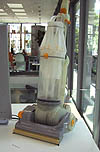
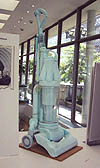
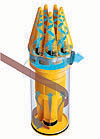


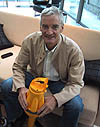


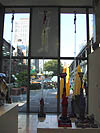
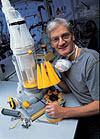


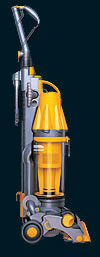
|



![]()













